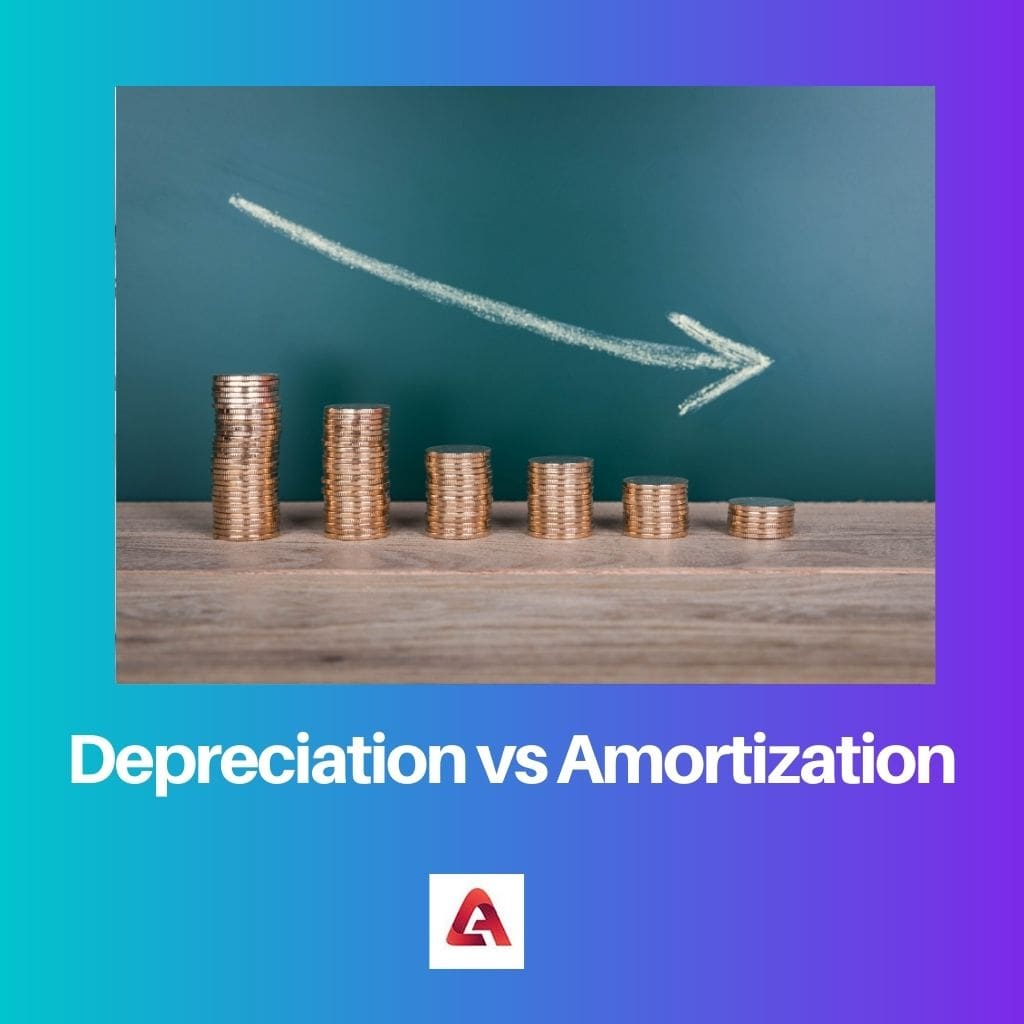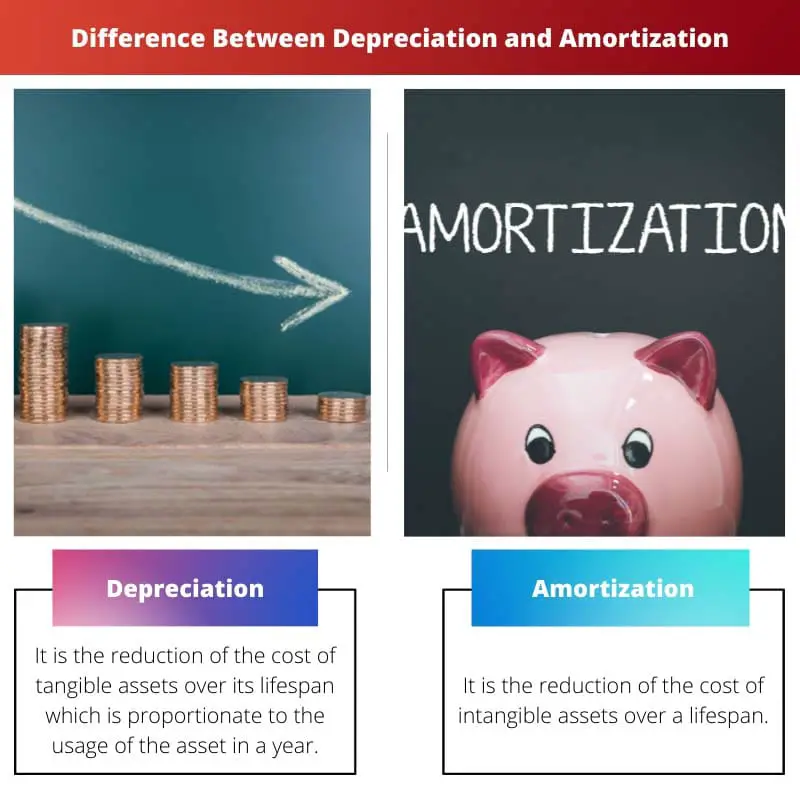La depreciación es la distribución de los costos de los activos tangibles a lo largo de su vida útil, principalmente para elementos físicos como maquinaria. La amortización, por otro lado, es el gasto gradual de los costos de los activos intangibles, como patentes o derechos de autor, a lo largo de su vida útil estimada. Ambos métodos tienen como objetivo hacer coincidir los gastos con los beneficios económicos del activo.
Puntos clave
- La depreciación es la asignación del costo de un activo tangible a lo largo de su vida útil. Al mismo tiempo, la amortización asigna el costo de un activo intangible a lo largo de su vida útil.
- La depreciación se aplica a activos físicos como edificios, vehículos y maquinaria, mientras que la amortización se aplica a activos intangibles como patentes, derechos de autor y licencias.
- Tanto la depreciación como la amortización son métodos contables utilizados para asignar costos y reducir la base imponible, pero se aplican a diferentes tipos de activos.
Depreciación vs Amortización
La depreciación representa la disminución en el valor de los activos tangibles, como maquinaria, equipo y edificios, debido al desgaste u obsolescencia. El costo del activo se distribuye a lo largo de su vida útil y se registra como una serie de gastos en los estados financieros de la empresa. La amortización representa la disminución del valor de los activos intangibles, como patentes, derechos de autor y marcas registradas. Similar a la depreciación, el costo del activo intangible se distribuye a lo largo de su vida útil y se registra como una serie de gastos en los estados financieros.

Tabla de comparación
| Feature | Depreciación | Amortización |
|---|---|---|
| A qué se aplica: | Activos tangibles: Activos físicos que pierden valor con el tiempo, como edificios, maquinaria, equipos, muebles, vehículos. | Activos intangibles: Activos no físicos con una vida útil finita, como derechos de autor, patentes, marcas comerciales, licencias de software, fondo de comercio. |
| Finalidad: | Reconocer el gasto del valor decreciente de un activo tangible a lo largo de su vida útil y compararlo con los ingresos que genera. | Distribuir el costo de un activo intangible a lo largo de su vida útil y adaptarlo a los beneficios que proporciona. |
| Método de cálculo: | Varía dependiendo de la normativa patrimonial y fiscal. Los métodos comunes incluyen línea recta, saldo de doble disminución y suma de dígitos de los años. | Generalmente utiliza el método de línea recta, distribuyendo el costo de manera uniforme a lo largo de la vida útil del activo. |
| Valor del rescate: | Considerado en algunos métodos de depreciación, reduciendo la base depreciable general. | Generalmente no se considera en la amortización, el costo total se distribuye a lo largo de la vida útil. |
| Impacto en los estados financieros: | Reduce tanto el valor del activo en el balance como el resultado neto de la empresa, generando un gasto de depreciación. | Reduce el valor del activo intangible en el balance y crea un gasto de amortización en la cuenta de resultados. |
| Implicaciones fiscales: | Los gastos de depreciación son deducibles de impuestos, lo que reduce la renta imponible. | Los gastos de amortización también son deducibles de impuestos, pero las reglas pueden variar según el activo y la jurisdicción. |
| Objetivo general: | Refleja con precisión la disminución del valor del activo a lo largo del tiempo y proporciona una imagen realista de la salud financiera de la empresa. | Garantizar una asignación justa del coste del activo intangible a lo largo de su vida útil y relacionarlo con precisión con los beneficios que genera. |
¿Qué es la depreciación?
La depreciación es un método contable utilizado para distribuir el costo de un activo tangible a lo largo de su vida útil. Refleja la disminución gradual del valor de un activo a medida que se utiliza en las operaciones comerciales.
Finalidad:
- Asignación de gastos: La depreciación permite a las empresas distribuir el costo de un activo a lo largo de varios períodos contables, alineando los gastos con los ingresos generados por el activo.
- Valoración de activos: Refleja el verdadero valor económico de un activo en el balance al contabilizar su valor decreciente con el tiempo.
Métodos:
- Método de la línea recta: Asigna una cantidad igual de gasto de depreciación cada año, calculada como (Costo – Valor de Rescate) / Vida Útil.
- Método de saldo decreciente: Anticipa la depreciación, asignando gastos más altos en los primeros años, utilizando un porcentaje fijo del valor contable restante.
- Método de Unidades de Producción: Cobra una cantidad variable según el uso o la producción real del activo, ideal para activos cuyo desgaste depende de los niveles de producción.
Ejemplos:
- Si una empresa compra maquinaria por $50,000 con una vida útil de 5 años y sin valor de rescate, utilizando el método de línea recta, el gasto de depreciación anual sería de $10,000 ($50,000 / 5).
- En el método del saldo decreciente, si la tasa de depreciación es del 20 %, el gasto del primer año sería de $10,000 50,000 ($20 XNUMX * XNUMX %) y el gasto del año siguiente se basaría en el valor contable restante.
Importancia:
La depreciación es crucial para obtener informes financieros precisos, deducciones fiscales y evaluar el costo real del uso de los activos a lo largo del tiempo. Ayuda a las empresas a tomar decisiones informadas con respecto al reemplazo, reparación o eliminación de activos.

¿Qué es la amortización?
La amortización es el proceso de distribuir el costo de un activo intangible a lo largo de su vida útil estimada. Este método contable se aplica a activos como patentes, derechos de autor, marcas comerciales y fondo de comercio.
Propósito
La amortización tiene como objetivo igualar el costo de los activos intangibles con los ingresos que generan a lo largo del tiempo. Refleja con precisión los beneficios económicos derivados del activo intangible en los estados financieros.
Cálculo
El monto de la amortización se calcula utilizando un enfoque de asignación sistemática, lineal u otro método que refleje el patrón de consumo del activo. La fórmula de amortización lineal es:
Gasto de Amortización = (Costo del Activo Intangible – Valor Residual) / Vida Útil Estimada
Lugar:
- El costo del activo intangible es el costo inicial.
- El Valor Residual es el valor estimado al final de la vida útil.
- La Vida Útil Estimada es el período previsto de beneficios económicos.
Informes financieros
Los gastos de amortización se registran en el estado de resultados, reduciendo los ingresos reportados. La amortización acumulada se refleja en el balance, reduciendo el valor en libros del activo intangible.
Ejemplo
Para una patente de 100,000 dólares con una vida útil de 10 años y sin valor residual, el gasto de amortización anual es de 10,000 dólares. Este importe se registra anualmente en la cuenta de resultados hasta su total amortización.

Principales diferencias entre depreciación y amortización
- Tipo de Activos:
- Depreciación: Se aplica a activos tangibles como maquinaria, edificios y vehículos.
- Amortización: Se aplica a activos intangibles como patentes, derechos de autor, marcas comerciales y fondo de comercio.
- Naturaleza de los activos:
- Depreciación: Implica el desgaste o deterioro físico de los activos tangibles a lo largo del tiempo.
- Amortización: Se relaciona con la carga gradual de los costos de los activos intangibles a lo largo de su vida útil estimada.
- Método de cálculo:
- Depreciación: Se calcula en función de factores como el costo, la vida útil y el valor de rescate, utilizando métodos como el de línea recta o el de saldo decreciente.
- Amortización: Se calcula de manera similar, considerando el costo, la vida útil y el valor residual, utilizando amortización lineal.
- Ejemplos de activos:
- Depreciación: Incluye activos como maquinaria, edificios, vehículos y muebles.
- Amortización: Incluye activos como patentes, derechos de autor, marcas comerciales y fondo de comercio.
- Físico versus no físico:
- Depreciación: Vinculado principalmente al deterioro físico u obsolescencia de activos tangibles.
- Amortización: Se refiere a la asignación de costos para activos intangibles no físicos.
- Impacto en los estados financieros:
- Depreciación: Reduce el valor contable de los activos tangibles en el balance e impacta en la cuenta de resultados.
- Amortización: Reduce el valor contable de los activos intangibles del balance y afecta a la cuenta de resultados.
- Aplicación comercial común:
- Depreciación: Comúnmente utilizado en manufactura, construcción e industrias con activos tangibles importantes.
- Amortización: Frecuente en industrias que se ocupan de propiedad intelectual, desarrollo de marcas y activos intangibles.

- https://academic.oup.com/qje/article-abstract/69/2/191/1873131
- https://www.ebr.edu.pl/pub/2014_2_63.pdf
Última actualización: 11 de febrero de 2024

Chara Yadav tiene un MBA en Finanzas. Su objetivo es simplificar los temas relacionados con las finanzas. Ha trabajado en finanzas durante unos 25 años. Ha impartido múltiples clases de finanzas y banca para escuelas de negocios y comunidades. Leer más en ella página de biografía.

Este artículo hace un gran trabajo al explicar las diferencias entre depreciación y amortización, y cómo ambos son métodos contables cruciales para las empresas. Es un recurso valioso para cualquiera que busque comprender estos conceptos.
Por supuesto, este artículo proporciona una descripción general completa de la depreciación y amortización, lo que lo hace accesible para lectores de todos los orígenes.
¡No podría estar más de acuerdo, Tony! Los ejemplos claros y las explicaciones detalladas hacen que este complejo tema sea mucho más fácil de entender.
El desglose en el artículo de los propósitos y métodos de la depreciación y la amortización proporciona una comprensión integral de estas prácticas contables tanto para profesionales como para individuos.
De hecho, el enfoque del artículo en las implicaciones de la depreciación y amortización para los estados financieros aumenta su relevancia para los lectores interesados en la gestión y el análisis financieros.
La discusión sobre el impacto de la depreciación y amortización en los estados financieros me pareció particularmente reveladora, ya que aclara su importancia en la información y el análisis financieros.
La comparación detallada del artículo y las explicaciones claras sobre la depreciación y amortización lo convierten en un recurso valioso para las personas que buscan profundizar su comprensión de los principios y prácticas contables.
No podría estar más de acuerdo, Jane. La cobertura completa de estos métodos contables en el artículo ofrece una sólida experiencia de aprendizaje para los lectores.
Absolutamente, las explicaciones detalladas y el enfoque estructurado de este artículo contribuyen a su eficacia a la hora de impartir conocimientos sobre depreciación y amortización.
La comparación entre depreciación y amortización se presenta de manera clara y organizada, lo que facilita a los lectores comprender las distinciones entre los dos métodos.
Estoy completamente de acuerdo Olivia. El enfoque estructurado de este artículo realza su valor como recurso educativo.
Sí, el diseño coherente de la tabla comparativa y las explicaciones detalladas posteriores contribuyen a la eficacia del artículo a la hora de transmitir las diferencias entre depreciación y amortización.
Esta publicación es bastante informativa y útil para propietarios de empresas y personas que necesitan navegar por el mundo de la gestión de activos y los métodos contables. Establece claramente las diferencias clave y los propósitos de la depreciación y amortización.
La tabla comparativa me pareció particularmente útil, ya que describe de manera sucinta las diferentes características de la depreciación y la amortización.
Aprecio cómo este artículo desglosa los métodos de cálculo tanto para la depreciación como para la amortización, proporcionando una comprensión profunda de los procesos involucrados.
Los ejemplos proporcionados para los métodos de cálculo de depreciación y amortización son claros e ilustrativos, ayudando en la comprensión de estas prácticas contables.
Por supuesto, la aplicación práctica de los métodos de cálculo a través de ejemplos enriquece la experiencia de aprendizaje que ofrece este artículo.
No podría estar más de acuerdo, Nyoung. El uso de ejemplos concretos mejora el valor educativo del artículo para los lectores que buscan aplicar estos conceptos en escenarios del mundo real.
El desglose completo de los métodos de cálculo y los propósitos de la depreciación y la amortización en este artículo proporciona una comprensión integral de sus funciones en la información financiera y los impuestos.
La discusión detallada sobre las implicaciones fiscales de la depreciación y la amortización me pareció particularmente esclarecedora, arrojando luz sobre su importancia en la planificación fiscal para las empresas.
Por supuesto, Maisie. La atención a las implicaciones fiscales añade una dimensión práctica a la exploración del artículo de estos métodos contables.
Si bien el artículo está bien escrito y es completo, creo que podría beneficiarse de más ejemplos del mundo real para ilustrar mejor los conceptos de depreciación y amortización.
Entiendo tu punto, Parker. Incluir escenarios más prácticos definitivamente mejoraría la aplicación de estos métodos contables.
Si bien el artículo describe efectivamente las diferencias entre depreciación y amortización, podría beneficiarse de un estilo de presentación más atractivo para garantizar la participación sostenida del lector.
Entiendo tu punto, Ruth. La incorporación de elementos interactivos o estudios de casos podría mejorar la participación y aplicabilidad del artículo para los lectores.
Estoy de acuerdo, Rut. Un enfoque más interactivo probablemente contribuiría a una experiencia de aprendizaje más dinámica para los lectores que interactúan con este contenido.
La exploración en profundidad de la depreciación y amortización del artículo proporciona una base integral para comprender estos métodos contables esenciales, lo que beneficia a los profesionales y estudiantes en el campo de las finanzas.
Absolutamente, Lcollins. El uso de ejemplos prácticos enriquece el valor educativo de este artículo, haciéndolo accesible y relacionable para una amplia audiencia.
Los ejemplos tangibles utilizados para explicar los conceptos de depreciación y amortización me parecieron particularmente eficaces para facilitar la comprensión y retención del material.